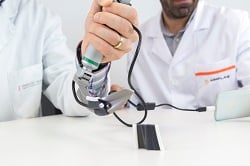R&D plastics and medicine: a low-cost plastic adapter to give sight to conventional laryngoscopes

AIMPLAS has taken part in the development of an innovative low-cost ‘videolaryngoscope’ that will allow the spread of this technology and its implementation in all the operating rooms where it was not due to the cost.

Each year, four million general anaesthesia are performed in Spain, which means one out of every ten people and anaesthetists deal, on a daily basis, with many assistances requiring the performance of an orotracheal intubation. This method involves passing a plastic tube between the vocal cords in order to ensure oxygenation and ventilation in patients. In order to undertake this technique a conventional laryngoscope is used to perform a direct laryngoscopy that allows seeing the vocal cords of the patient and thus leading the tube to the right place. This manoeuvre may fail with different frequency degree. According to the physical characteristics of the patient, the manoeuvre may develop complications if the vocal cords are not seen, what result in a margin of error higher than 20 % in some cases. It is an unforeseen event that is only shown at the moment of the intubation and whose solution is the use of a kit of specific devices to manage the airway. Videolaryngoscopes are the most effective in these cases, although they have a high cost that limits its use.
Doctor Lucas Rovira, anesthesiologist, currently working at the Manises Hospital, has created and led the project CLEVERSCOPE. The project has received funding from the Medical Research Institute La Fe (IIS La Fe) and the department of Design and Injection of AIMPLAS has taken part in it, thanks to the agreement REDIT- Medical Research Institute La Fe. The main objective of this project is to make possible the implementation of advanced equipments that solve these complicated operations and the result has been protected by shared utility model between La Fe and AIMPLAS.
Vicente Ruedas, expert in Design and Injection at AIMPLAS, adds: ‘in this first stage of conceptual development of the product, it has been essential the use of additive manufacturing technologies to evaluate the behaviour in use of the supporting part’. The result has been the manufacturing of a prototype consisting in three parts that, placed in a conventional laryngoscope in a smartphone or tablet with camera, turn it into a high-performance videolaryngoscope.